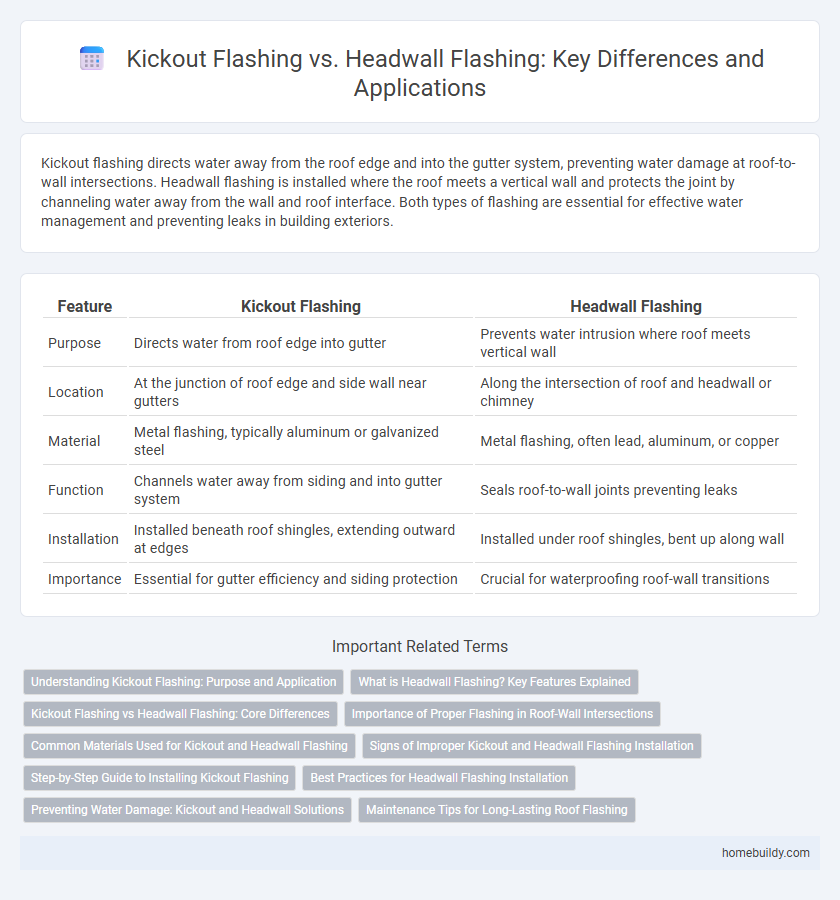Kickout flashing directs water away from the roof edge and into the gutter system, preventing water damage at roof-to-wall intersections. Headwall flashing is installed where the roof meets a vertical wall and protects the joint by channeling water away from the wall and roof interface. Both types of flashing are essential for effective water management and preventing leaks in building exteriors.
Table of Comparison
| Feature | Kickout Flashing | Headwall Flashing |
|---|---|---|
| Purpose | Directs water from roof edge into gutter | Prevents water intrusion where roof meets vertical wall |
| Location | At the junction of roof edge and side wall near gutters | Along the intersection of roof and headwall or chimney |
| Material | Metal flashing, typically aluminum or galvanized steel | Metal flashing, often lead, aluminum, or copper |
| Function | Channels water away from siding and into gutter system | Seals roof-to-wall joints preventing leaks |
| Installation | Installed beneath roof shingles, extending outward at edges | Installed under roof shingles, bent up along wall |
| Importance | Essential for gutter efficiency and siding protection | Crucial for waterproofing roof-wall transitions |
Understanding Kickout Flashing: Purpose and Application
Kickout flashing directs water away from the wall and into the gutter system, preventing water infiltration and damage at roof-to-wall intersections. Unlike headwall flashing, which seals the joint between the roof and a vertical wall, kickout flashing specifically extends beyond the siding to channel water effectively. Proper installation of kickout flashing is critical to protect the building envelope and prolong the lifespan of exterior cladding.
What is Headwall Flashing? Key Features Explained
Headwall flashing is a type of flashing installed where a roof meets a vertical wall or chimney to prevent water infiltration at the joint. It is typically made from durable materials such as aluminum, copper, or galvanized steel, designed to channel water away from the intersection and protect the structure from leaks. Key features include a reglet or groove for secure attachment, a cant strip for directing water flow, and a counter flashing to cover the base flashing, ensuring a watertight seal along the vertical surface.
Kickout Flashing vs Headwall Flashing: Core Differences
Kickout flashing directs water away from the roof and wall intersection to prevent water intrusion at the base of the siding, while headwall flashing is installed at the junction of a roof and vertical wall to channel water off the roof surface. Kickout flashing typically extends outward to divert water into the gutter system, whereas headwall flashing ensures a watertight seal between the horizontal roof plane and vertical wall. Understanding these core differences aids in effective moisture management and prevents structural damage.
Importance of Proper Flashing in Roof-Wall Intersections
Proper flashing at roof-wall intersections prevents water infiltration and structural damage, ensuring building longevity. Kickout flashing directs water away from the wall face, while headwall flashing seals the joint where the roof meets the vertical wall, together forming a critical barrier against leaks. Installing these flashings correctly minimizes mold growth and costly repairs by maintaining effective water diversion.
Common Materials Used for Kickout and Headwall Flashing
Common materials used for kickout flashing include aluminum, galvanized steel, and copper, chosen for their durability and resistance to water infiltration at roof-wall intersections. Headwall flashing typically utilizes similar metals but often incorporates flexible flashing materials like EPDM or neoprene for enhanced sealing around complex shapes. Both types prioritize corrosion resistance and weatherproofing to protect structural integrity and prevent moisture damage.
Signs of Improper Kickout and Headwall Flashing Installation
Signs of improper kickout flashing installation include water stains or rot on the exterior wall below the roofline and peeling paint near the flashing area, indicating water is not being properly diverted away from the siding. Improper headwall flashing installation often results in visible gaps, cracked sealant, or sheet metal corrosion, allowing moisture infiltration and subsequent damage to the roof-wall junction. Identifying these signs early helps prevent mold growth, wood decay, and structural issues around roof intersections.
Step-by-Step Guide to Installing Kickout Flashing
Install kickout flashing by first measuring and cutting the aluminum flashing to extend beyond the wall and roof intersection. Secure the flashing under the siding or cladding, ensuring it directs water away from the wall and into the gutter system. Seal edges with high-quality roofing sealant to prevent water infiltration and improve durability.
Best Practices for Headwall Flashing Installation
Best practices for headwall flashing installation include ensuring a continuous, watertight seal by properly integrating the flashing with the roofing and siding materials. Use corrosion-resistant metal or flexible membrane flashing that extends beneath the roofing and wraps behind the wall cladding to direct water away from the structure. Precise alignment, secure fastening, and overlapping seams are critical to prevent water infiltration and enhance long-term durability.
Preventing Water Damage: Kickout and Headwall Solutions
Kickout flashing directs water away from roof edges into gutters, preventing water infiltration and damage to the building's siding and foundation. Headwall flashing seals the junction between the roof and vertical walls, effectively stopping water from seeping behind siding or exterior cladding. Both kickout and headwall flashing are essential components in a well-designed water management system, significantly reducing the risk of structural damage and mold growth.
Maintenance Tips for Long-Lasting Roof Flashing
Kickout flashing directs water away from the roof-to-wall intersection, preventing leaks by channeling runoff safely into gutters, while headwall flashing seals joints where the roof meets a vertical wall, protecting against water infiltration. Regular inspections should include checking for cracks, rust, or loose fasteners in both kickout and headwall flashings to maintain their integrity. Applying sealant annually and removing debris buildup ensures effective water diversion and prolongs the lifespan of roof flashing systems.
Kickout flashing vs Headwall flashing Infographic

 homebuildy.com
homebuildy.com